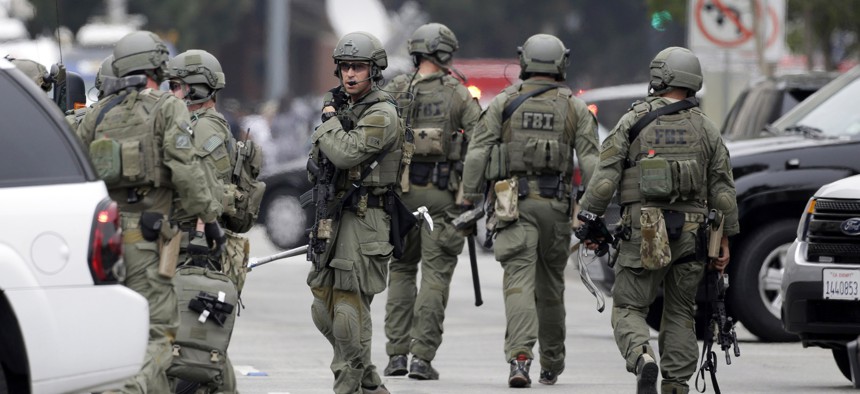
An FBI SWAT team arrives at the scene of a fatal shooting at the University of California, Los Angeles, Wednesday, June 1, 2016, in Los Angeles AP / Nick Ut
After A Shooting, What Do Security Pros Do Behind Closed Doors?
Wednesday’s attack on a congressional baseball practice will trigger re-evaluations of security posture, and decisions on next steps.
Even as a high-profile shooting like Wednesday’s attack at a congressional baseball practice flashes onto cable news networks, it triggers deeper, behind-the-scenes evaluations among security personnel, local police, and federal investigators, all of whom will look at their policies and asset deployments using data from the incident.
“There’s a trickle-down effect that causes all the government agencies with high-profile individuals to re-evaluate their security posture collectively across the government,” says Fred Burton, a former deputy chief of counterterrorism at the State Department’s Diplomatic Security Service and now head of security for Stratfor.
Once the dust settles, says Burton, the Washington D.C. Joint Terrorism Task Force will begin a criminal investigation, seeking to understand the actions of the alleged shooter, identified as James T. Hodgkinson, an out-of-work home inspector from Belleville, Illinois. The shooting victims include Rep. Steve Scalise, R-Louisiana, the House Majority Whip; and two Capitol Police officers who brought down Hodgkinson under fire.
The FBI Joint Terrorism Task Forces, or JTTFs “are small cells of highly trained, locally based, investigators, analysts, linguists, SWAT experts, and other specialists from dozens of U.S. law enforcement and intelligence agencies,” based in more than 100 cities across the country, according to the FBI’s website. Among the questions that the task force will likely ask: How long was he planning the attack and what methods did he use in that planning? “That will give you a window” into other potential soft spots, Burton said. “Did he datamine this on the web? Did he see [the event] on a blog? [Hear about it] on the radio? What was the trigger?”
Investigators will also likely look at whether the shooter was driven by a specific animus toward his targets or a vaguer rage that manifested when the opportunity presented itself. That, in turn, may affect future decisions about where and how to place officers.
“You’re hoping to get specific data from this person to say, ‘I’ve fixated just on this one elected representative,’” Burton said. “Therefore, the threat would not necessarily apply to the entire elected body of the U.S. Congress. Your challenge is: if the shooter’s intent was just to shoot congresspeople, it’s much more broad. You’re going to elevate the threat posture along the capital and re-assess large-scale congressional gatherings like this. You’ll be updating threat assessments for whenever you have x number of congresspeople at any one venue. You’ll be looking at previously threatened individuals.”
Other authorities, particularly the Capitol Police, will look at whether they had properly assessed the threat at the baseball practice. They will certainly redo the threat assessment for the Congressional Baseball Game scheduled for Thursday. “I guarantee you, by tomorrow, someone will say, ‘Was a threat assessment done at this public event?’ An event that was well known, that occurs a day before a huge event at Nats Stadium. Those are the sorts of questions that will happen behind closed doors.”
The Capitol Police may also look at whether the Alexandria Police were notified about the practice beforehand. “Would uniform patrol coverage act as a deterrent in this case? There’s nothing that precludes the U.S. Capitol Police from sending uniformed police cars to this type of event either, which will be another question I would be asking.”
Local forces will mount internal investigations to focus on “what else could have been in place to mitigate this threat before the first round was fired,” said Burton.
Longer term, the question becomes what sort of equipment might someday help to protect events like a baseball practice. “I would be looking at technology tools to help me attack the pre-operational surveillance aspect of the attack cycle,” said Burton. That could include social media analysis tools to better threatening posts that could warn about criminal behavior.
“I would also be looking for surveillance technology to help me in the field,” he said. “Would there be any kind of technology solutions that perhaps could have been set up an hour before this event that might have noticed something suspicious. Is there drone technology for example, that could be used in a pre-operational surveillance capacity. If I’m part of the Capitol Police protective detail and I get there an hour before this event -- which is normal -- could I put a drone up to scan the area?”





